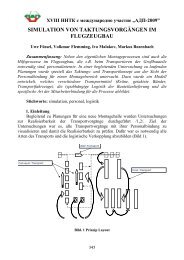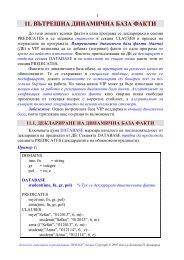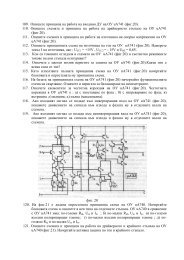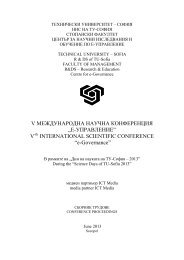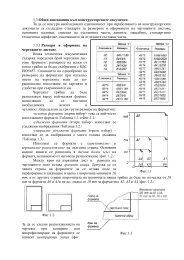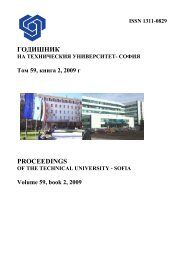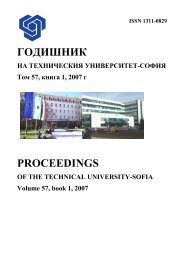Volume 61 Issue 2 (2011) - Годишник на ТУ - София - Технически ...
Volume 61 Issue 2 (2011) - Годишник на ТУ - София - Технически ...
Volume 61 Issue 2 (2011) - Годишник на ТУ - София - Технически ...
- No tags were found...
Create successful ePaper yourself
Turn your PDF publications into a flip-book with our unique Google optimized e-Paper software.
* x4. Order of approximationBecause the basis functions of the Chaikin scheme are splines, we directly use givenin [6] estimation for the best uniform approximation of smooth functions with splines.This assessment states that the difference between f (x)and its best uniform approximationp ( ) with splines is* ( k 1)! h ( j)| f p | || f || , (7)( k 1 j)! 2 where h is the maximum distance between nodes, and j is random integer in therange 1 j min{ k 1, l). In the last inequality k is the degree of splines, and l isthe largest number for which3j(l)f is continuous. Because the Chaikin scheme hask 2 the functions f ( x) C get maximum value for j 3. In this case, the nodesare equidistant and at the beginning are h 1 selected. This makes no problems whensomebody wants to improve accuracy. If the received accuracy is not enough, it initiallymakes a shrinkage in abscissa axis, for example by division of the 2 . The bestmuniform approximation of f is found, then the original scale of this axis is recoveredmby multiplying it by 2 . Obviously in this upscaling the uniform distance between fand its approximation is not increased. Estimation (7) is rough [6], because it is derivedusing the following procedure. A uniform approximation of f (x)by splines ofdegree k is obtained and for this approximation is derived an inequality. This inequalityis summarized by induction and inequality (7) is obtained. Consequently, inequality(7) is effective also for the best uniform approximation of f with splain ofdegree k . This does not exclude the possibility that the best uniform approximation off is better than that obtained in (7).5. ConclusionThe proposed method of "memorizing" of elementary functions uses only a few points(from zero level) and the remaining points (from a higher level) are generated by theChaikin scheme. This scheme uses only operations addition and multiplication by 1/4and 3/4. Therefore, this scheme is very simple for computer implementation. However,the method gives satisfactory accuracy.REFERENCES[1] N.Dyn, Subdivision schemes in computer aided geometric design, in Advances inNumerical Analysis II, Wavelets, Subdivision Algorithms and Radial Functions,W.A.Light, ed., Oxford University Press, 1991,36-104[2] N.Dyn, J.A.Gregory and D.Levin, Analysis of Uniform Binary SubdivisionSchemes for Curve Design, Constr.Approx.(1991)7:127-147[3] G.Nurnberger: A local version of Haar’s theorem in approximations theory,Numer. Funct. Anal. Optimiz. ,21-46(1982)45



